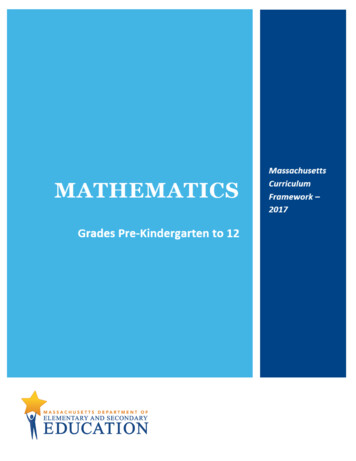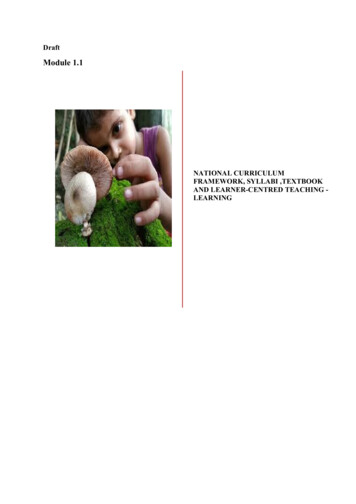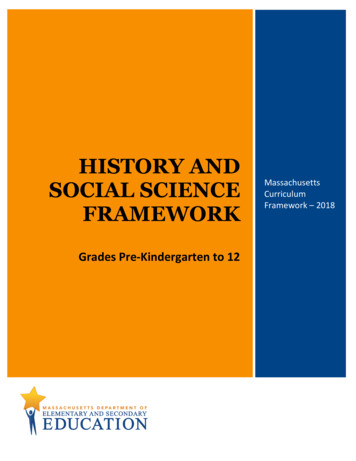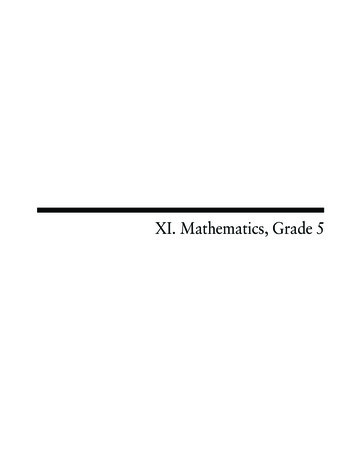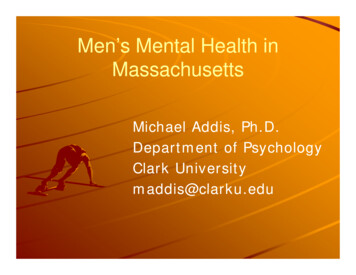
Transcription
MassachusettsComprehensive HealthCurriculumFrameworkOctober, 19991
Dear Colleagues,I am pleased to present to you the Massachusetts Comprehensive Health Curriculum Framework that was adoptedby the Board of Education in September 1999. This second edition of the Comprehensive Health CurriculumFramework presents the new statewide guidelines for learning, teaching, and assessment in health for theCommonwealth’s public schools. Based on scholarship, sound research, and effective practice, the Framework willenable teachers and administrators to strengthen curriculum and instruction from PreKindergarten through grade 12.I am proud of the work that has been accomplished. The comments and suggestions received on the first edition ofthe Comprehensive Health Curriculum Framework of 1996, as well as comments on subsequent working drafts,have strengthened this new edition. I want to thank everyone who worked with us to create a high quality documentthat provides challenging learning standards for Massachusetts students.We will continue to work with schools and districts in implementing the Comprehensive Health CurriculumFramework over the next several years, and we encourage you to offer us your comments as you use it. All of thecurriculum frameworks are subject to continuous review and improvement, for the benefit of the students of theCommonwealth.Thank you again for your ongoing support and commitment to achieving the goals of education reform.Sincerely,David P. DriscollCommissioner of EducationiMassachusetts Comprehensive Health Curriculum FrameworkOctober, 1999i
Table of ContentsSECTION I Overview5SECTION II Introduction8SECTION III Core Concept10SECTION IV Guiding Principles11SECTION V Considerations in Health Education16SECTION VI Strands and Learning Standards17Physical Health Strand18Growth and Development20Physical Activity and Fitness23Nutrition27Reproduction/Sexuality30Social and Emotional Health Strand33Mental Health35Family Life38Interpersonal Relationship41Safety and Prevention Strand44Disease Prevention and Control46Safety and Injury Prevention49Tobacco, Alcohol, and Other Substance Use/Abuse Prevention52Violence Prevention55Personal and Community Health Information Strand58Consumer Health and Resource Management60Ecological Health63Community and Public Health65APPENDICESA Massachusetts Guiding Principles and National Standards68B Law & Policy Around Health and Health Education72C Technology Literacy and Health Education81REFERENCES AND SOURCES84SELECTED RESOURCES86iiMassachusetts Comprehensive Health Curriculum FrameworkOctober, 1999ii
Massachusetts Comprehensive HealthCurriculum Framework1Massachusetts Comprehensive Health Curriculum FrameworkOctober, 19991
Massachusetts Comprehensive HealthCurriculum FrameworkCore ConceptHealth Literacy / Healthy Self-Management Skills / Health PromotionGuiding PrinciplesComprehensive Health Education is:I. Sequential, PreK–12, Coordinated Teaching of Health, Physical Education, and Family and ConsumerSciencesII. Assessment of Risks, Consideration of Consequences, and Making Healthy DecisionsIII. Communication of Health InformationIV. Acknowledgment of Similarities and Differences to Create a Safe and Supportive EnvironmentV. Collaboration Among Components to Strengthen the Coordinated School Health ProgramStrandsPhysical HealthSocial & EmotionalHealthSafety & PreventionPersonal &Community HealthStandardsStandardsStandardsStandards Growth andDevelopment Mental Health Disease Prevention andControl Consumer Health andResource Management Safety and InjuryPrevention Ecological Health Physical Activity &Fitness Nutrition Reproduction/Sexuality Family Life InterpersonalRelationships Tobacco, Alcohol andOther SubstanceUse/Abuse Prevention Community and PublicHealth Violence Prevention2Massachusetts Comprehensive Health Curriculum FrameworkOctober, 19992
PreK–12 Standards3Massachusetts Comprehensive Health Curriculum FrameworkOctober, 19993
Pre-K–12 StandardsGrowth & DevelopmentPhysical Activity & FitnessNutritionReproduction/SexualityMental HealthFamily LifeInterpersonalRelationshipsDisease Prevention &ControlsSafety & Injury PreventionTobacco, Alcohol, & otherSubstancesViolence PreventionConsumer Health &Resource ManagementEcological HealthCommunity & PublicHealthStudents will learn the basic characteristics of physical growth and development,including body functions and systems throughout the life cycle, and will acquire skills topromote and maintain positive growth and development.Students will, by repeated practice, acquire and refine a variety of manipulative,locomotor, and non-locomotor movement skills, and will utilize principles of training andconditioning, will learn biomechanics and exercise physiology, and will apply the conceptof wellness to their lives.Students will gain the knowledge and skills to select a diet that supports health andreduces the risk of illness and future chronic diseases.Students will acquire the knowledge and skills necessary to make effective personaldecisions that promote their emotional, sexual, and reproductive health.Students will acquire knowledge about emotions and physical health, the management ofemotions, personality and character development, and social awareness; and will learnskills to promote self-acceptance, make decisions, and cope with stress, including suicideprevention.Students will gain knowledge about the significance of the family on individuals andsociety, and will learn skills to support the family, balance work and family life, be aneffective parent, and nurture the development of children.Students will learn that relationships with others are an integral part of the human lifeexperience and the factors that contribute to healthy interpersonal relationships, and willacquire skills to enhance and make many of these relationships more fulfilling throughcommitment and communication.Students will learn the signs, symptoms, and treatment of chronic and communicablediseases, and will gain skills related to health promotion, disease prevention, and healthmaintenance.Students will gain the knowledge and skills to administer first aid and carry outemergency procedures, including cardiopulmonary resuscitation, will avoid, recognize,and report verbal, physical, and emotional abuse situations, and will assess the factors thatcontribute to intentional and unintentional injury, including motor vehicle accidents, firesafety, and weapons safety.Students will acquire the knowledge and skills to be competent in making healthenhancing decisions regarding the use of medications and avoidance of substances, and incommunicating about substance use/abuse prevention for healthier homes, schools, andcommunities.Students will learn how their actions affect others, will understand the power that positivecharacter traits can have in violence prevention, will gain skills to report incidents ofviolence and hurtful behavior to adults in the school and community, will avoid engagingin violence, and identify constructive alternatives to violence, including how to discourageothers from engaging in violence.Students will acquire the knowledge and skills necessary to obtain, manage, and evaluateresources to maintain physical and mental health and well being for themselves, theirfamily, and the community.Students will gain knowledge of the interdependence between the environment andphysical health, and will acquire skills to care for the environment.Students will learn the influence of social factors on health and contribution of publichealth, and will gain skills to promote health and to collaborate with others to facilitatehealthy, safe, and supportive communities.4Massachusetts Comprehensive Health Curriculum FrameworkOctober, 19994
OverviewCore ConceptThrough health literacy, healthy self-management skills, and health promotion, comprehensive health educationteaches fundamental health concepts, promotes habits and conduct that enhance health and wellness, and guidesefforts to build healthy families, relationships, schools, and communities.Fundamental health knowledge and skills need to be taught starting in pre-kindergarten and early elementary years,and reinforced and expanded regularly in subsequent grades. A planned, sequential curriculum addresses a variety oftopics with increasing degrees of complexity appropriate to students’ developmental levels as they move from earlyto middle childhood and then into adolescence. Such a program ensures thorough, balanced coverage of healthcontent areas, and its success relies on skilled teachers who readily adapt to incorporate emerging health topics.Guiding PrinciplesComprehensive Health education teaches students fundamental health concepts and skills that foster healthy habitsand behaviors for the individual and others through sequential and coordinated teaching of health education,physical education, and family and consumer sciences education at each grade level, prekindergarten through grade12.Comprehensive Health education teaches students to use fundamental health concepts to assess risks, to considerpotential consequences, and to make health enhancing decisions.Comprehensive Health education teaches skills that assist students to understand and communicate healthinformation clearly for self-management and health promotion.Comprehensive Health education contributes to the capacity of students to work in a positive manner with families,school staff, peers, and community members to enhance personal health and create a safe and supportiveenvironment where individual similarities and differences are acknowledged.Comprehensive Health education is strengthened through collaboration and partnerships among all components ofthe coordinated school health program and other subjects.5Massachusetts Comprehensive Health Curriculum FrameworkOctober, 19995
Strands and StandardsSTRANDPhysical Health StrandStudents will recognize decisionsthat all individuals will make withrespect to their bodies in dailyliving and identify the relationshipsamong actions, conduct andwellness.PREK–12 STANDARDSPreK–12 Standard 1 GROWTH AND DEVELOPStudents will learn the basic characteristics of physical growth anddevelopment, including body functions and systems throughout the life cycle,and will acquire skills to promote and maintain positive growth anddevelopment.PreK–12 Standard 2 PHYSICAL ACTIVITY & FITNESSStudents will, by repeated practice, acquire and refine a variety ofmanipulative, locomotor, and non-locomotor movement skills, and will utilizeprinciples of training and conditioning, will learn biomechanics and exercisephysiology, and will apply the concept of wellness to their lives.PreK–12 Standard 3 NUTRITIONStudents will gain the knowledge and skills to select a diet that supportshealth and reduces the risk of illness and future chronic diseases.PreK–12 Standard 4 REPRODUCTION/SEXUALITYSocial and Emotional HealthStrandelop skills needed in daily life as theycome to learn about their identityand how to manage interactionswith other people.uire the knowledge and skills necessary to make effective personal decisionsthat promote their emotional, sexual, and reproductive health.PreK–2 Standard 5 MENTAL HEALTHStudents will acquire knowledge about emotions and physical health, themanagement of emotions, personality and character development, and socialawareness; and will learn skills to promote self-acceptance, make decisions,and cope with stress, including suicide prevention. .PreK–12 Standard 6 FAMILY LIFEStudents will gain knowledge about the significance of the family onindividuals and society, and will learn skills to support the family, balancework and family life, be an effective parent, and nurture the development ofchildren. .PreK–12 Standard 7 INTERPERSONAL RELATIONSHIPSn that relationships with others are an integral part of the human lifeexperience and the factors that contribute to healthy interpersonalrelationships, and will acquire skills to enhance and make many of theserelationships more fulfilling through commitment and communication.PreK–12 Standard 8 DISEASE PREVENTION AND CONTROLSafety and Prevention Strandhow they make decisions and weighStudents will learn the signs, symptoms, and treatment of chronic andthe probable consequences of theircommunicable diseases, and will gain skills related to health promotion,actions.disease prevention, and health maintenance.PreK–12 Standard 9 SAFETY AND INJURY PREVENTIONStudents will gain the knowledge and skills to administer first aid and carryout emergency procedures, including cardiopulmonary resuscitation, willavoid, recognize, and report verbal, physical, and emotional abuse situations,and will assess the factors that contribute to intentional and unintentionalinjury, including motor vehicle accidents, fire safety, and weapons safety.PreK–12 Standard 10 TOBACCO, ALCOHOL & OTHER SUBSTANCEUSE/ABUSE PREVENTIONStudents will acquire the knowledge and skills to be competent in makinghealth-enhancing decisions regarding the use of medications and avoidanceof substances, and in communicating about substance use/abuse prevention6Massachusetts Comprehensive Health Curriculum FrameworkOctober, 19996
for healthier homes, schools, and communities.PreK–12 Standard 11 VIOLENCE PREVENTIONPersonal and CommunityHealth Strandelop a clearer understanding of theirpersonal, social and civicresponsibilities by acting onaccurate information to improvehealth in their communities.n how their actions affect others, will understand the power that positivecharacter traits can have in violence prevention, will gain skills to reportincidents of violence and hurtful behavior to adults in the school andcommunity, will avoid engaging in violence, and identify constructivealternatives to violence, including how to discourage others from engaging inviolence.PreK–12 Standard 12 CONSUMER HEALTH AND RESOURCE MANAGEMENTStudents will acquire the knowledge and skills necessary to obtain, manage,and evaluate resources to maintain physical and mental health and wellbeing for themselves, their family, and the community.PreK–12 Standard 13 ECOLOGICAL HEALTHStudents will gain knowledge of the interdependence between theenvironment and physical health, and will acquire skills to care for theenvironment.PreK–12 Standard 14 COMMUNITY AND PUBLIC HEALTHn the influence of social factors on health and the contribution of public health,and will gain skills to promote health and to collaborate with others tofacilitate healthy, safe, and supportive communities.7Massachusetts Comprehensive Health Curriculum FrameworkOctober, 19997
IntroductionThe purpose of the Massachusetts Comprehensive Health Curriculum Framework is to provide guidance forMassachusetts school districts in designing local programs to guide the acquisition of the knowledge, skills, andhabits needed by students. Comprehensive health education includes health education, physical education, andfamily and consumer sciences education. Teachers within these subjects need to work collaboratively withcounselors, school nurses, nutrition services staff, other teachers, families, and students from pre-kindergartenthrough grade 12.The Framework synthesizes current research and sets learning standards for students from pre-kindergarten throughgrade twelve. The Framework presents a broad outline upon which Massachusetts school health curricula,instruction, and locally designed and administered assessments can be based.Organization of the Health Curriculum Framework The Core Concept presents the fundamental purpose of a comprehensive health curriculum. The Guiding Principles direct and inform health education and the building of school communities thatpromote the health and well being of students, families, teachers, and staff. The Strands organize the areas included in comprehensive health education as outlined in theMassachusetts General Laws, particularly Chapter 71. (see Appendix B) The PreK-12 Standards define topic oriented content and set expectations for knowledge and skills thatstudents should acquire from their study in health. The Learning Standards reflect measurable student competencies and are grade span specific (PreK-5,6-8, 9-12). Selected examples are provided in the Framework. The Interdisciplinary Learning Objectives included in several Health strands provide sampleopportunities to address health content within other subject areas, i.e., History & Social Sciences andMathematics. The Appendices present (A) a comparison of the Massachusetts Health Curriculum Framework GuidingPrincipals with the National Standards for Health Education, Physical Education and Family and ConsumerSciences; (B) selected Laws and Policies relating to Health Education in Massachusetts schools; and (C)guidance on developing Technology Literacy Skills through Health Education. The Selected Resources and Health Websites provide quick reference to sources of Health Educationinformation.This Health Framework is built upon the work of the panel who developed the first Health Framework. The currentHealth Framework was developed by a committee of Massachusetts teachers of health, physical education, familyand consumer sciences, health educators from higher education, physicians, and school nurses. The HealthFramework is intended to be used in conjunction with the other Massachusetts Curriculum Frameworks to makeconnections among all subjects.There are specific areas of particular relevance to health education. Two of these that are notable are the linksbetween health and school performance, and health education and family involvement.Education in all subjects can be more effective when health is a priority throughout the school. Health and learningare closely related. Students who are unhealthy or troubled are students whose learning may not be optimal. Becausegood health is linked with better school performance, schools have a vested interest in preventing risk behaviors thathave a negative impact on health.1 For example, students who use tobacco products can experience difficultyconcentrating. Alcohol and drug use impairs the brain’s ability to process information, form memories, and recallinformation. Teen pregnancy is related to dropping out of school. Poor nutrition decreases cognitive functioning inthe areas of language, concentration, alertness, and attention.8Massachusetts Comprehensive Health Curriculum FrameworkOctober, 19998
Some students who have participated in school health education programs, compared to similar students who havenot participated in such programs, have increased cognitive development and awareness, better school attendance,higher graduation rates, increased goal-setting, and better application of decision-making skills. Certain componentsof the school health program have also been found to be related even more directly to school performance. Forexample, after controlling for other explanatory factors, participation in school breakfast programs was associatedwith increased scores in mathematics, language, and reading, and with decreases in school absence and tardiness.Similar results have been found with students who participated in more comprehensive school health programs. Forexample, students at risk for school failure who participated in school-linked health and human services hadimproved grades and earned more credits compared to similar peers who did not receive such services.Even as adults, education is related to less involvement in certain risk behaviors and higher participation in healthybehaviors. The results of a recent survey conducted by the Massachusetts Department of Public Health amongMassachusetts adults found a relationship between more years of education and several health related behaviors,such as lower rates of smoking, eating the recommended daily allowance of fruits and vegetables, and participationin recommended levels of physical activity.Today, Massachusetts students face many potential health problems related to their social environment, but the riskbehaviors associated with these problems are largely preventable. Comprehensive health education addresses theknowledge and skills for both reducing risk behaviors and increasing actions and habits that increase wellness.A major component of comprehensive school health education is parental and family involvement. Parents andfamilies are their children's first and continuing teachers and they influence the health decisions that are made bytheir children. Family and community involvement is important in the planning of appropriate health education andin strengthening health lessons and skills development. Schools have historically worked side by side with familiesand communities to promote acceptable standards of conduct and the attributes that foster them, such as civility andbeing responsible for one’s actions. Health education supports this through an emphasis on skills of decisionmaking, problem-solving, and critical thinking for responsible conduct.Comprehensive health education occurs in relation to many contextual factors. Health sometimes involves sensitivetopics that may have social, economic, genetic, or religious implications. Of note, Massachusetts public schoolsmust notify parents before implementing curriculum that involves human sexuality. The approach of theMassachusetts Comprehensive Health Curriculum Framework is to encourage each district to work with family andcommunity members in the development and implementation of the health education curriculum in the schools ofthat district.1The following research is cited in the References and Sources of the Framework.9Massachusetts Comprehensive Health Curriculum FrameworkOctober, 19999
Core ConceptThrough health literacy, self-management skills, and health promotion, comprehensive health education teachesfundamental health concepts, promotes habits and conduct that enhance health and wellness, and guides efforts tobuild healthy families, relationships, schools, and communities.Health Literacy focuses on acquisition of knowledge and includes: the capacity to obtain, understand, and evaluate health information and services;learning about physical changes and how the body functions; andknowledge of the relationship between movement and health.Through reading, observation, discussion, and actions students learn to locate information and assess its reliability,make reasoned decisions based on accurate information, and apply their knowledge to their own health and safety.Students learn what it is to be healthy, about development, and about the importance of physical fitness in theiroverall level of health and wellness. Health literacy is critical for healthy self-management and health promotion.Healthy Self-Management enables students to: integrate and apply knowledge and skills with respect to their health-related decisions, actions, andconduct; learn to assume increased responsibility for their health-related decisions, actions, and conduct; and consider potential consequences and evaluate outcomes.Healthy self-management entails self-assessment, goal setting, and decision-making based on an understanding ofrisk and probability. By practicing a repertoire of developmentally appropriate behaviors that promote health,students can significantly increase the likelihood of good physical, emotional, cognitive, social, and environmentalhealth.Health Promotion helps students demonstrate: competence in using information and services;how to present accurate information about health; andthe capability to respond to health concerns, including emergencies.Knowledge and good communication skills are critical to health promotion. Students learn how to present factualinformation about health in ways that promote responsible actions while still considering the rights of individuals.Health promotion can take many forms. By contributing to improvements in the health of the natural environmentand the physical safety of their communities, students learn what can be accomplished by an individual as well as bya group. Students work with families, school staff, and community members to determine concrete steps they cantake to build a strong social fabric that fosters positive growth and development.Fundamental health knowledge and skills need to be taught starting in pre-kindergarten and early elementary years,and reinforced and expanded regularly in subsequent grades. A planned, sequential curriculum addresses a variety oftopics with increasing degrees of complexity appropriate to students’ developmental levels as they move from earlyto middle childhood and then into adolescence. Such a program ensures thorough, balanced coverage of healthcontent areas, and its success relies on skilled teachers who readily adapt to incorporate emerging health topics.10Massachusetts Comprehensive Health Curriculum FrameworkOctober, 199910
Guiding PrinciplesThe Massachusetts Curriculum Frameworks define and describe what all students should know, understand, and beable to do as a result of the education provided to them in the Commonwealth’s public schools. The inclusion ofcomprehensive health education as a major component of the Massachusetts Curriculum Frameworks signals thefundamental importance of health and learning. Comprehensive health education imparts health knowledge andassists students in developing skills which promote health-enhancing behaviors. The guiding principles emphasizethe importance of learning and practicing both content and skills as complimentary elements of sequentiallyplanned, developmentally appropriate health education Pre-K through Grade 12. The following principles highlightthe most important ideas that should inform the design of all comprehensive health education programs inMassachusetts.Guiding Principle 1Comprehensive Health education teaches students fundamental health concepts and skills that fosterhealthy habits and behaviors for the individual and others through sequential and coordinated teachingof health education, physical education, and family and consumer sciences education at each gradelevel, prekindergarten through grade 12.Comprehensive health education provides a foundation in public health, medical knowledge, and modes of inquiryinto how individuals and societies acquire their health-related knowledge, and empowers students to changeunhealthy attitudes and behaviors. Students learn factual information and develop skills for finding and evaluatinginformation and resources, for making decisions, and for setting goals to promote their own health and the health ofothers. These others may include family, friends, coworkers, neighbors, etc. Physical education focuses on bodydynamics, movement, physical fitness, competition, and teamwork. Family and Consumer Sciences educationexamines the concepts of personal living, family life, parenting, work, nutrition, and consumerism.Health education, physical education, and family and consumer sciences education each contribute tocomprehensive health education. Together they increase students' knowledge of health concepts, life managementskills, and habits that can facilitate lifelong health for the individual and for others. To be most effective, healthshould be taught regularly, beginning with a student's entry into school and continuing through grade 12. Asequential curriculum introduces concepts and skills in the early grades and reinforces them with more detailed andcomplex information and skills in the later grades.Guiding Principle IIComprehensive Health education teaches students to use fundamental health concepts to assess risks, toconsider potential consequences, and to make health enhancing decisions.Comprehensive health education equips students to assess risks in an informed manner in their everyday lives.Students learn how to identify and evaluate various types and degrees of health risk and become aware of specificbehaviors that pose risks for themselves and others, now and in the future. Students learn how to determine thelikely consequences of their actions and how to determine which information is needed to assess health risks and tomake responsible decisions. Influences on personal health, including why people relapse into unhealthy conduct andbehaviors and how relapse can sometimes be prevented, are important health concepts.Comprehensive health education teaches students to inquire and solve problems competently. Students set goals,appraise risks, and demonstrate behaviors and conduct that protect and enhance their health. In this way, and inpartnership with families and communities, health education supports the resilience of students.11Massachusetts Comprehensive Health Curriculum FrameworkOctober, 199911
Guiding Principle IIIComprehensive Health education teaches skills that assist students to understand and communicatehealth information clearly for self-management and health promotion.Comprehensive health education teaches students to identify health information and resources that are current andapplicable to their lives. Students learn the types of questions to ask and information to provide when talking withhealth professionals.In our society, health information is communicated through a variety of means, such as through health careproviders, the media, including professional publications, and health-related events. Through health education,students acquire media literacy by learning to determine if health information is accurate, with whom to share healthinformation, and how to avoid communicating inaccurate information. Health education provides criteria forinterpreting conflicting health research and in finding resources for independent research into health topics.Guiding Principle IVComprehensive Health education contributes to the capacity of students to work in a positive mannerwith families, school staff, peers, and community members to enhance personal health and c
Physical Activity and Fitness 23 . Nutrition 27 . Reproduction/Sexuality 30 . Social and Emotional Health Strand 33 . Mental Health 35 . Family Life 38 . Interpersonal Relationship 41 . Safety and Prevention Strand 44 . Disease Prevention and Control 46 . Safety and Injury Prevention 49 . Tobacco, Alcohol, and Other Substance Use/Abuse .
